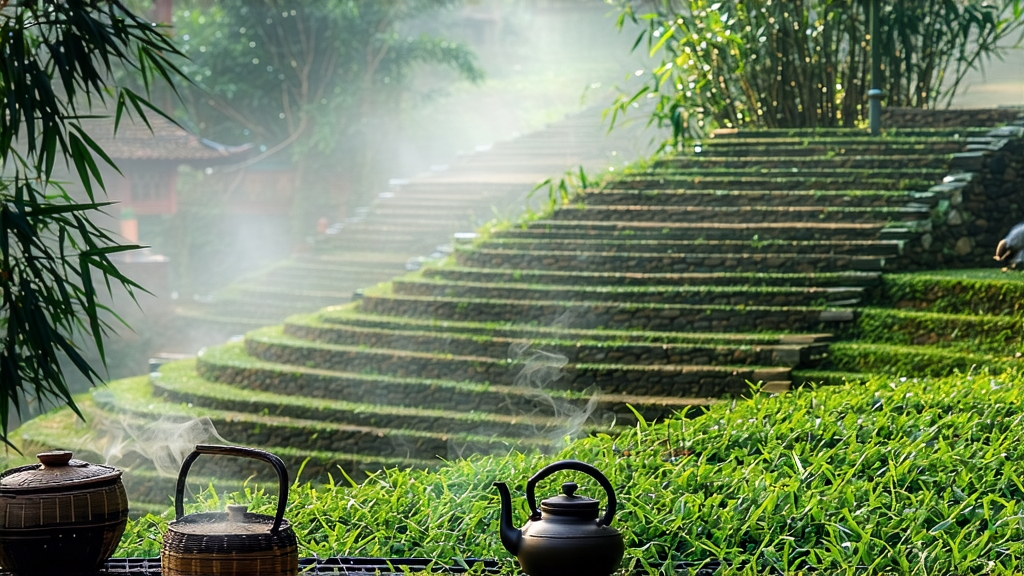
Tucked away in the subtropical mountains of southern China, Liu Bao tea has spent four centuries quietly perfecting the art of fermentation. To most Western drinkers “dark tea” begins and ends with shou Pu-erh, yet Liu Bao is the older, subtler sibling that inspired the very process now synonymous with Yunnan’s ripe cakes. Its story starts during the Ming dynasty, when leaf travelling the Tea Horse Road from Guangxi’s Wuzhou prefecture was packed in bamboo husks and rattled along rivers until the jostling, steaming cargo arrived at the border markets of Macau and Hong Kong. Merchants noticed that the deeper the tea had fermented en route, the faster it sold; soon they were accelerating nature in humid storerooms along the Pearl River Delta. By Qing times Liu Bao had become a medicine chest staple for Cantonese labourers and a currency for overseas Chinese communities in Southeast Asia, who valued its ability to settle stomachs heavy with coconut milk and spice.
Liu Bao is not a single cultivar but a protected geographical indication: only leaf picked within the six original townships of Cangwu county, then processed inside Wuzhou’s city limits, may bear the name. Growers favour the medium-leaf Quntizhong heirloom bush, whose thick cell walls survive repeated wok-firing and months of wet piling without collapsing into dust. After the spring plucking—two leaves and a bud—arrives at the village cooperative, the tea is withered under banana-leaf shades for two hours, just long enough to soften the edges. A short 200 °C tumble in an iron drum halts oxidation at the green stage, but unlike green tea the leaves are immediately bruised by foot in a narrow concrete trough; this controlled cracking liberates enzymes that will later drive the microbial fermentation. While still warm the leaf is piled 70 cm deep inside a pine-lined chamber, sprayed with mineral-rich water drawn from the Xun River, and covered with jute sacks. For the next twenty-five days the pile breathes at 28 °C and 85 % humidity, hosting a rotating cast of Aspergillus niger, Blastobotrys adeninivorans and the prized golden yeast Wickerhamomyces anomalus. Every seven days the pile is turned by shovel, aerating the centre so that fermentation proceeds evenly; by the end the leaves have turned chestnut-brown and exude the scent of wet earth, nutmeg and dried longan.
The final act is aging, and here Liu Bao diverges from Pu-erh’s stone-pressed cakes. The tea is packed un-pressed into forty-kilogram bamboo baskets woven fresh from river reeds; the airy lattice allows residual moisture to escape while imbuing a faint grassy sweetness. These baskets are stacked in limestone caves whose year-round 22 °C microclimate nudges the tea through decades of slow maturation. Locals speak of “three years medicine, seven years treasure, twenty years liquid jade”; indeed, a 1996 basket recently opened at the Wuzhou Tea Factory revealed leaves the colour of ebony and a liquor that tastes like black-forest gateau soaked in camphor.
To brew Liu Bao respectfully you need only a clay kettle and patience. Begin by rinsing the teapot with boiling water; use 5 g of leaf for every 120 ml of vessel, then flash-rinse for five seconds to awaken the dormant spores. The first proper infusion should be ten seconds at 100 °C, poured in a thin stream to aerate the liquor. Expect an aroma of petrichor and burnt molasses; the sip is silky, slightly sweet, with a returning coolness on the edges of the tongue that Cantonese call “gum hau”. Steepings may be extended by five seconds each round; a quality Liu Bao yields twelve infusions before the flavour collapses, the final cups tasting of dried jujube and river stone. For a darker profile popular in Malaysia, simmer 3 g in 500 ml of water for three minutes, then serve in small glasses with palm-sugar cubes—a preparation known as “kopi teh” because the colour resembles coffee yet the finish is tea.
Professional cupping follows a quieter rhythm. Warm the gaiwan, add 3 g of leaf, shake and inhale: top notes should suggest damp bark, hint of salted plum, no trace of sour compost. After the first infusion examine the spent leaves